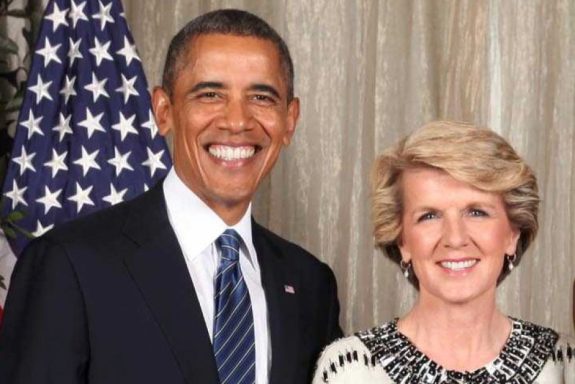Good luck in Paris

On 19 June 2013, Greg Hunt said on Sky News:
“We agree on the national targets to reduce our emissions by five per cent by 2020. We also agree on the renewable energy target. And one of the things we don’t want to do is to become a party where there is this wild sovereign risk where you are, where businesses take steps to their detriment on the basis of a pledge and a policy of Government.”
In July 2013 at the Clean Energy Week conference Labor’s Yvette D’Ath explicitly challenged the Coalition’s representative at the conference, Simon Birmingham, to stop talking about a 20 per cent target and make it clear whether it would keep the target at 41,000GWh.
Birmingham responded without fluffing around, stating that the Coalition supported the RET as currently legislated with its fixed 41,000GWh target.
While Hunt now does a Pyne by saying when they committed to a 20% Renewable Energy Target before the election what they really meant was…..followed by some fancy backpedalling… his own Department website still states
“The large-scale targets ramp up until 2020 when the target will be 41,000 gigawatt-hours of renewable electricity generation.”
When pressed about the 41,000 target in an interview on Rupert Murdoch’s Sky News on August 28 2014 Hunt said
“Look, with respect, our promise – is that our policy was for a 20 per cent, for a 20 per cent Renewable Energy Target, but that there would be a review which had to come, by law, under the ALP’s own law, it was due to come this year.”
He seems to ignore the fact that the “law” states quite clearly that it is the Climate Change Authority that must conduct the review, not a hand-picked panel of climate sceptics and fossil fuel lobbyists.
The Warburton Report also clearly states
The expanded RET scheme, which commenced in January 2010, is designed to ensure at least 20 per cent of Australia’s electricity comes from renewable sources by 2020. To achieve this, the legislation contains annual targets for large-scale renewable generation, expressed in gigawatt hours (GWh) that rise each year to 41,000 GWh in 2020.
Whilst coming up with the predictable recommendation that “In the presence of lower cost alternatives, the costs imposed by the RET are not justifiable,” they could not hide the facts.
“Analyses suggest that, overall, the RET is exerting some downward pressure on wholesale electricity prices. This is not surprising given that the RET is increasing the supply of electricity when electricity demand has been falling.
The direct costs of the RET currently increase retail electricity bills for households by around four per cent, but modelling suggests that the net impact of the RET over time is relatively small.
The Panel found that the RET has broadly met its objectives. It has encouraged significant additional renewable electricity generation, with output from large-scale renewable generators having almost doubled as a result of the scheme. Installations of small-scale systems have exceeded expectations, with output from these systems already exceeding levels anticipated for 2020. To date, the RET has delivered a modest level of carbon dioxide equivalent (CO2-e) emissions reductions. Commonwealth, state and territory environmental regulation provides a framework for ensuring that the RET promotes the use of ecologically sustainable renewable energy sources.
Over the past five years demand for electricity has been significantly lower than forecast and electricity demand in 2020 is now expected to be much lower than when the current RET was adopted. At the same time the cost of renewable technologies has fallen, particularly for rooftop solar photovoltaic (PV) systems. These factors mean that the RET could achieve a 26 per cent share of electricity from renewable sources by 2020.”
Perhaps the real reason for the panel’s recommendations is revealed by the statement that the renewable energy target results in “a transfer of wealth among participants in the electricity market” and we can’t have that now can we. If anyone’s going to get wealthy here it must be the coal miners, not those wind farm people who are making us all sick.
And so much for the One Million Solar Roofs. When asked about this, the Minister’s office said “the Government will take due care and consideration in the design and implementation of any further large initiatives to support solar energy”. Coalition speak for another broken election promise.
The Energy White Paper simultaneously delivers the message that we must privatise to increase competition and keep prices down whilst decrying the competition provided by the renewable energy sector because the increased supply has driven down prices.
The Direct Action Plan has become pointless with toothless safeguard mechanisms to punish polluters who increase emissions.
“Direct Action has no point if it does not have an effective safeguards mechanism and what the government has released seems like a try-on,” Nick Xenophon said. “It goes against what they promised me in the discussions before the vote. I was assured this safeguards mechanism would have real teeth. There is no point in the government spending $2.55bn if there is no requirement to cap or reduce emissions from industry.”
It is becoming increasingly impossible to believe this government has any intention of accepting the burden of addressing emissions reduction. Good luck in Paris is all I can say.
Like what we do at The AIMN?
You’ll like it even more knowing that your donation will help us to keep up the good fight.
Chuck in a few bucks and see just how far it goes!









